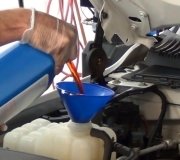Are you in a warm climate or stuck outside in a snow bank?
At the dealership, I removed the radiator cap, removed one heater hose at the engine, and disconnected the hose going to the reservoir at the radiator. This was at a Chrysler dealership. GM does their reservoirs differently, but this procedure should still work. Do not pull a heater hose off the firewall. Many GM cars use plastic nipples that can break when pulling the hoses off. Others are usually brass, but you do not want to risk breaking a solder joint. Disconnect the lower radiator hose from the radiator or the engine, whichever is easier. I will never use the radiator petcock to drain coolant. There are too many of them that are plastic valves in a plastic tank, and they either cut their rubber o-rings or they leak after they have been opened. It is common for them to drip one drop about once every five seconds.
Use the water from a garden hose to run water into the heater hose. It will flow through the heater core, then back into the engine and out the lower hose. Run some water into the engine where you removed the heater hose from. Run some through the radiator, then, reconnect the lower hose, then run water in the heater hose again and block the port on the engine. That will run water up into the radiator and out the top, either at the cap or the reservoir hose port. Let that all drain out.
I used a pressure washer to fill the reservoir and clean the gunk off the inside, but a garden hose will work too. Fill the reservoir and hold the hose down as much as possible. Once water flows through that hose, it will siphon the water out onto your foot!
Reassemble all the hoses. It is important now to understand there is water in the heater core and water in the engine that will never drain out. If you simply fill with a 50 / 50 mix of water and antifreeze, you will end up with too little antifreeze. I consider it a scam that any company would try to sell me a gallon of fifty percent water. Instead, add one gallon of straight antifreeze. By the way, if your car had the miserable Dex-Cool, (Dex-Mud) antifreeze, this is a good chance to switch to something better. Now add a gallon of straight water. Two gallons is close to filling most engines. If coolant starts pouring out of the port at the top of the radiator, you will have a full gallon of antifreeze and about a gallon of water, considering what is already in there. Run the engine to mix the coolant and fill the heater core. If the system is not full yet, add another half gallon of antifreeze, then, if necessary, another half gallon of water.
Many engines need to have the air burped from the cooling system. Thermostats need to be hit with hot liquid to open. Hot air will not do it. Look for a bleeder screw on the thermostat housing. You can also remove a threaded plug or temperature sensor on or near the housing to let the air out as you continue filling the system. If you have to remove a two-wire coolant temperature sensor, do that with the ignition switch off to avoid setting a diagnostic fault code that could confuse someone in the near future.
Once the coolant has been circulating for a few minutes, use a tester to read the freeze point. You still have the reservoir to fill, and you can add water or antifreeze as necessary to bring the freeze point as close to minus thirty five degrees as possible.
Also, be aware adding straight antifreeze does not provide any benefit. I do not know how this correlates with all the new antifreeze formulations that have popped up in the last ten to fifteen years, but before that, straight water freezes at plus thirty two degrees, and straight antifreeze froze at around minus ten degrees. Mixing them chemically is what brings the freeze point down to a maximum of minus forty five to fifty degrees. It is important to understand that almost all freeze point testers measure the weight of the mixture in relation to the weight of water. Antifreeze is heavier, so straight antifreeze shows up on those testers as having an unrealistic freeze point of something like minus ninety degrees. In reality, the freeze point is going back up toward minus ten degrees. Those testers are pretty accurate down to about minus forty or forty five degrees, so do not get lulled into a false sense of security when you see a reading lower than that.
If you want to get truly accurate results, you need a "refractometer". That is a tool you place a drop of liquid onto the small piece of glass, (which must be perfectly clean), then you sight through it like a small telescope. The top of the viewing area will be much brighter than the lower half. The line where the bright and dark areas meet is where you take the reading on a scale on the side.
Monday, December 26th, 2016 AT 3:47 PM




